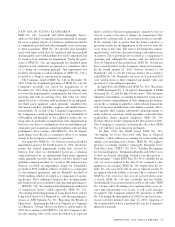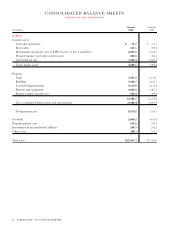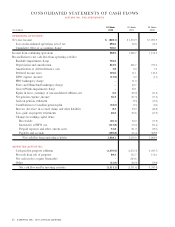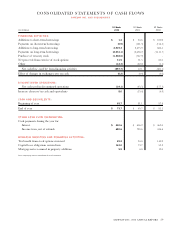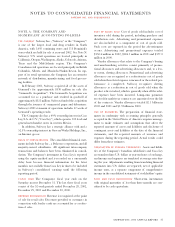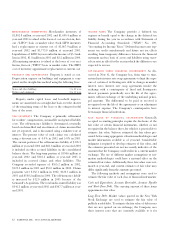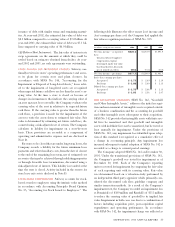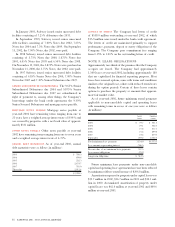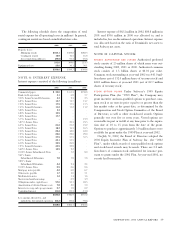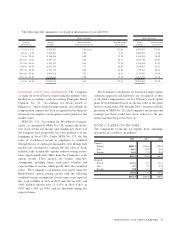Safeway 2002 Annual Report Download - page 33
Download and view the complete annual report
Please find page 33 of the 2002 Safeway annual report below. You can navigate through the pages in the report by either clicking on the pages listed below, or by using the keyword search tool below to find specific information within the annual report.
SAFEWAY INC. 2002 ANNUAL REPORT 31
NOTES TO CONSOLIDATED FINANCIAL STATEMENTS
SAFEWAY INC. AND SUBSIDIARIES
NOTE A: THE COMPANY AND
SIGNIFICANT ACCOUNTING POLICIES
THE COMPANY Safeway Inc. (“Safeway” or the “Company”)
is one of the largest food and drug retailers in North
America, with 1,695 continuing stores and 113 Dominick’s
stores which are held for sale at year-end 2002. See Note N.
Safeway’s U.S. retail operations are located principally in
California, Oregon, Washington, Alaska, Colorado, Arizona,
Texas and the Mid-Atlantic region. The Company’s
Canadian retail operations are located principally in British
Columbia, Alberta and Manitoba/Saskatchewan. In sup-
port of its retail operations, the Company has an extensive
network of distribution, manufacturing and food process-
ing facilities.
In February 2001, Safeway acquired all of the assets of
Genuardi’s for approximately $530 million in cash (the
“Genuardi’s Acquisition”). The Genuardi’s Acquisition was
accounted for as a purchase and resulted in goodwill of
approximately $521 million. Safeway funded the acquisition
through the issuance of commercial paper and debentures.
Safeway’s 2001 statement of operations includes 47 weeks of
Genuardi’s operating results.
The Company also has a 49% ownership interest in Casa
Ley, S.A. de C.V. (“Casa Ley”), which operates 102 food and
general merchandise stores in western Mexico.
In addition, Safeway has a strategic alliance with and a
52.5% ownership interest in GroceryWorks Holdings, Inc.,
an Internet grocer.
BASIS OF CONSOLIDATION The consolidated financial state-
ments include Safeway Inc., a Delaware corporation, and all
majority-owned subsidiaries. All significant intercompany
transactions and balances have been eliminated in consoli-
dation. The Company’s investment in Casa Ley is reported
using the equity method and is recorded on a one-month
delay basis because financial information for the latest
month is not available from Casa Ley in time to be included
in Safeway’s consolidated earnings until the following
reporting period.
FISCAL YEAR The Company’s fiscal year ends on the
Saturday nearest December 31. The last three fiscal years
consist of the 52-week periods ended December 28, 2002,
December 29, 2001 and December 30, 2000.
REVENUE RECOGNITION Revenue is recognized at the point
of sale for retail sales. Discounts provided to customers in
connection with loyalty cards are accounted for as a reduc-
tion of sales.
COST OF GOODS SOLD Cost of goods sold includes cost of
inventory sold during the period, including purchase and
distribution costs. Advertising and promotional expenses
are also included as a component of cost of goods sold.
Such costs are expensed in the period the advertisement
occurs. Advertising and promotional expenses totaled
$350.4 million in 2002, $384.1 million in 2001 and $377.0
million in 2000.
Vendor allowances that relate to the Company’s buying
and merchandising activities consist primarily of promo-
tional allowances and advertising allowances and, to a less-
er extent, slotting allowances. Promotional and advertising
allowances are recognized as a reduction in cost of goods
sold when the related expense is incurred or the related per-
formance is completed. Safeway recognizes slotting
allowances as a reduction in cost of goods sold when the
product is first stocked, which is generally when all the relat-
ed expenses have been incurred. Lump-sum payments
received for multi-year contracts are amortized over the life
of the contracts. Vendor allowances totaled $2.1 billion in
2002 and 2001 and $1.9 billion in 2000.
USE OF ESTIMATES The preparation of financial state-
ments in conformity with accounting principles generally
accepted in the United States of America requires manage-
ment to make estimates and assumptions that affect the
reported amounts of assets and liabilities and disclosure of
contingent assets and liabilities at the date of the financial
statements, and the reported amounts of revenues and
expenses during the reporting period. Actual results could
differ from those estimates.
TRANSLATION OF FOREIGN CURRENCIES Assets and liabili-
ties of the Company’s Canadian subsidiaries and Casa Ley
are translated into U.S. dollars at year-end rates of exchange,
and income and expenses are translated at average rates dur-
ing the year. Adjustments resulting from translating financial
statements into U.S. dollars are reported, net of applicable
income taxes, as a separate component of comprehensive
income in the consolidated statements of stockholders’ equity.
CASH AND CASH EQUIVALENTS Short-term investments
with original maturities of less than three months are con-
sidered to be cash equivalents.




